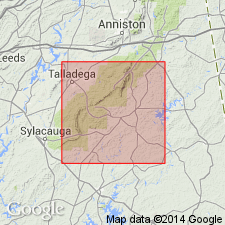
- Usage in publication:
-
- Pinckneyville granite
- Modifications:
-
- Named
- Dominant lithology:
-
- Granite
- AAPG geologic province:
-
- Piedmont-Blue Ridge province
Summary:
Name Pinckneyville granite introduced for biotite granite, covering large area around Pinckneyville, Clay Co., eastern AL. As mapped it includes the belts of biotite granite "locally designated as Bluff Springs granite." Intrudes Talladega phyllites. Age given as post-Carboniferous. [See also Prouty (1922: Elisha Mitchell Sci. Soc. Jour., v. 38, p. 16) and Prouty (1922: Alabama Geol. Survey Co. Rept. 1, p. 51-62).]
Source: GNU records (USGS DDS-6; Reston GNULEX).
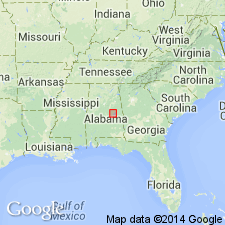
- Usage in publication:
-
- Pinckneyville quartz diorite complex
- Modifications:
-
- Redescribed
- Overview
- Dominant lithology:
-
- Quartz diorite
- Gneiss
- Granodiorite
- AAPG geologic province:
-
- Piedmont-Blue Ridge province
Summary:
Unit referred to as Pinckneyville quartz diorite complex, originally described as granite, is one of largest intrusions in AL. Underlies area extending from Coosa River in northwest Elmore Co., northeast through Coosa and Tallapoosa Cos., into Clay Co. Dark-gray coarse-grained quartz diorite gneiss constitutes major part of complex. Contains smaller amounts of granodiorite and granite gneiss. Intrudes Ashland mica schist and Wedowee formation. Age uncertain.
Source: GNU records (USGS DDS-6; Reston GNULEX).
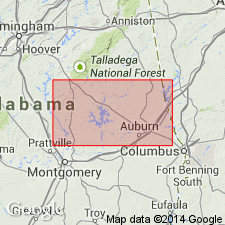
- Usage in publication:
-
- Pinckneyville Granite complex
- Modifications:
-
- Revised
- AAPG geologic province:
-
- Piedmont-Blue Ridge province
Summary:
Pinckneyville Granite complex includes Elkahatchee Granite and Rockford Granite. Occurs in eastern AL and western GA. Complex is no younger than 324+/-10 m.y.
Source: GNU records (USGS DDS-6; Reston GNULEX).
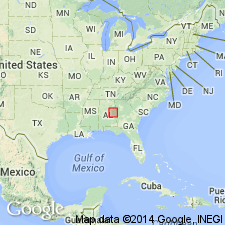
- Usage in publication:
-
- Pinckneyville Granite Complex
- Modifications:
-
- Revised
- AAPG geologic province:
-
- Piedmont-Blue Ridge province
Summary:
Of the numerous granites scattered throughout the northern AL Piedmont, the largest complex is the Pinckneyville, which lies along the southwest side of the southern structural dome. It is divided into the mesocratic Elkahatchee Quartz Diorite and the leucocratic Rockford Granite.
Source: GNU records (USGS DDS-6; Reston GNULEX).
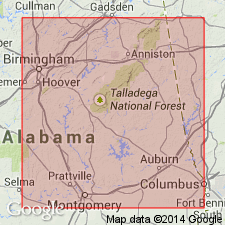
- Usage in publication:
-
- Pinckneyville Granite Complex
- Modifications:
-
- Overview
- AAPG geologic province:
-
- Piedmont-Blue Ridge province
Summary:
Nomenclature of Neathery (1968) is followed in this report. Unit consists of three major lithologies: biotite-quartz diorite gneiss, granodiorite, and late plutonic granite. No age given.
Source: GNU records (USGS DDS-6; Reston GNULEX).
For more information, please contact Nancy Stamm, Geologic Names Committee Secretary.
Asterisk (*) indicates published by U.S. Geological Survey authors.
"No current usage" (†) implies that a name has been abandoned or has fallen into disuse. Former usage and, if known, replacement name given in parentheses ( ).
Slash (/) indicates name conflicts with nomenclatural guidelines (CSN, 1933; ACSN, 1961, 1970; NACSN, 1983, 2005, 2021). May be explained within brackets ([ ]).

